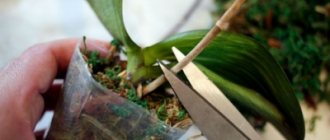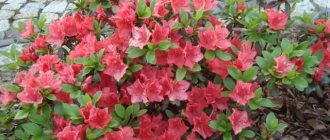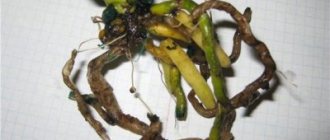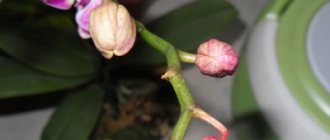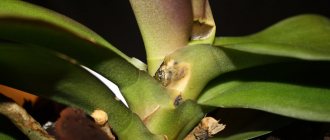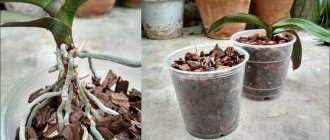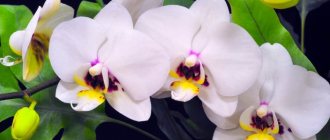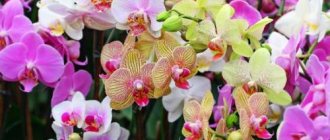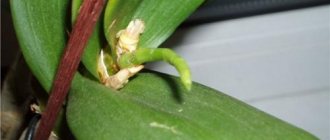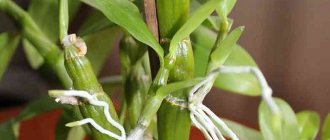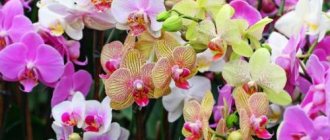Lush and long-lasting flowering depends on the living conditions in the apartment. They should be as close as possible to natural for this type of orchid. The frequency and duration of flowering depend on the variety and age of the orchid, lighting, humidity, and temperature. The article provides information about the periods and methods of stimulation, and describes the characteristics of the flowering of Phalaenopsis and Cattleya. It is described how to create favorable conditions during flowering and during the dormant period. The pros and cons of pruning the flower stalk are presented. The reasons for the withering and dropping of buds and flowers are indicated.
Frequency and duration
An orchid first blooms at 2-4 years of age, seedlings at 4-5 years. The number of formed leaves for the release of a peduncle is 5-8 pieces. The time during which an orchid blooms depends on the plant variety, growing conditions and care.
Usually the plant blooms once a year, for a period from several weeks to 3, 5, sometimes 8 months . Under natural conditions, flowering occurs during the dry summer season. In the northern hemisphere, this period corresponds to winter. In the natural environment, when the plant has flowered, the wind carries the seeds over a distance of several kilometers.
One peduncle, if not cut off, may bloom again. During this period, the orchid is intensively watered and fertilizing is used: succinic acid, vitamins in capsules, store-bought and home-prepared fertilizers.
An orchid at home is capable of flowering until it reaches the age of 10 years. Some varieties stop blooming after reaching 3 years. With improper care, the period is reduced, but under optimal, close to natural conditions, it increases. One flower blooms for 3-4 weeks. Full disclosure occurs within 24 hours.
Flowering period depending on the type of orchid:
- Cymbidium . October – February (in some sources – March), or from March to September. The peduncle is tied to supports, watering is reduced, and fertilizers are eliminated. Favorable temperature: 16-180C.
- Miltonia ("Butterfly Wings", "Pansies"), Miltassia . They bloom from March to June. Duration is 5-6 weeks. The temperature during the flowering period should be 18-220C.
- Dendrobium , Cymbidium . They bloom from early October to January (in some sources until the end of winter), sometimes in summer. Flowers - white, white-pink, crimson, lilac with a yellow center, lilac. To stimulate flowering, place the plant in a bright, cool place and stop watering.
- Oncidium blooms from April to July. Sometimes again - at the end of autumn, with a frequency of 1 time every 8-12 months. It may happen more often as the shoots develop.
- Paphiopedilum (“Slippers”, “Venus’s slipper”). The flowering period is from October to March. The rest period is not expressed. Good lighting and sufficient watering are provided throughout the year. In nature, this species is adapted to a lack of light (at the same time, Paphiopedilums are not shade-loving!) and high soil moisture.
- Odontoglossum . Flowering - late winter - early summer, for 2-3 months.
- Zygopetalum blooms from November to February, once or twice a year. Flowers in shades of green, brown, white and purple with spots and streaks.
Other conditions on which the period and duration of flowering depend:
- lighting,
- humidity,
- temperature.
The plant is replanted every two to three years. Signals for transplantation :
- Aerial roots have little space in the flowerpot and are located very close to each other. Perhaps they began to rot (due to too much compaction of the soil).
- Leaves, buds, and flowers turn yellow and wither. Occurs due to insufficient nutrition of the orchid through the roots on a dense substrate.
- Insects in the soil. The plant is taken out of the pot, the roots are washed in warm water, the pot and soil are changed.
- Viral, bacterial, fungal diseases. The roots are washed, the diseased parts are cut off, the sections are sprinkled with charcoal, cinnamon, and treated with hydrogen peroxide. The flowerpot and soil are changed.
After this, the orchid needs time to adapt, which takes up to 3 years. During this period the plant does not bloom.
Phalaenopsis
Flowering duration is from 2 to 8 months , beginning in December (in some sources - in January). Blooms up to three times during the year. 2-40 inflorescences of snow-white, dark scarlet, yellow and red shades are formed. Sometimes the color is blue. Flowers last up to 4 months.
Long flowering does not always have a positive effect on Phalaenopsis. Young and old plants that bloom for more than 3 months will use up all their strength, which will lead to the death of the orchid. The same applies to recently recovered and transplanted plants.
So, in order to interrupt unwanted prolonged flowering, the peduncle is carefully trimmed. The cut area is treated with cinnamon, charcoal or hydrogen peroxide. The plant is not watered for 2 days. The dried stump is covered with wax to prevent the penetration of bacteria and rotting. Fertilizer is applied to maintain the strength of the orchid.
Unlike Cattleya, Phalaenopsis lacks pseudobulbs and rhizomes, but has many aerial roots. The light must be diffused (Cattleya requires more light, including direct sunlight in the morning and evening - in summer, throughout the day - in cloudy weather and in winter).
To lay the buds of the peduncle, a dormant period of one to two months is organized. The temperature should be 160C. When buds appear, make sure that the temperature does not drop below 160C. If there is not enough light or the temperature is low, the buds will fall off.
The correct light and temperature can be ensured by moving Phalaenopsis to a balcony or loggia in the summer. The plant must be shaded from aggressive sunlight.
Important! An orchid can die in direct sunlight and in a draft.
A period of rest is required for Phalaenopsis. The plant rests and gains strength for the next flowering.
Interesting! The end of the dormant period is determined by the color of the root system. Uniform coloring means that the plant is dormant, green tips signal that the orchid is growing. Watering during this period is increased.
Cattleya
Flowering period - mid-spring - early winter, throughout the year. Duration – 4 weeks. If an orchid has 3 or more pseudobulbs, it blooms once every 8 months, with a dormant period. The development of a peduncle from a bud can take up to 4 months. The buds open sequentially. When the Cattleya orchid has bloomed, a period of dormancy begins. Reduce the intensity of watering and stop fertilizing.
Cattleya requires the following conditions for normal growth, development and, of course, flowering:
- The difference between day and night temperatures is 5-70C. In summer 22-280C during the day and 170C at night. In winter, 16-180C during the day and not lower than 120C at night. In the morning and evening, the plants are placed in the sun for several hours. Be careful: too aggressive sun causes burns.
- In the warm season, the pot with Cattleya is placed in a tray with water or wet pebbles. The water used is soft (settled, filtered or melted), lukewarm or at room temperature. Dive time – 10 minutes. This will ensure that many new aerial roots are produced.
- Water the substrate directly, avoiding water getting on the leaves and flowers of the plant. If a few drops get on the leaves or in the axils, dry with a napkin. Otherwise, brown spots will form where the liquid gets in.
- Feed the orchid, alternating with watering: watering - watering + feeding - watering, until a cover is formed at the base of the leaf. Then they stop fertilizing and start again when a bud appears.
Conventionally, Cattleya orchids are divided into two groups: those that bloom in spring and autumn. For autumn plants, the release of peduncles will be stimulated by a reduction in daylight hours. For spring, on the contrary, it increases.
Possible problems and useful tips for solving:
- The flower stalk is drying up. Insufficient watering, lighting or fertilizing.
- The leaves and pseudobulbs have become yellowish - there is too much light. If the leaves are a rich dark green color, there is not enough lighting.
Cattleya orchid
Cattleya, like other species and varieties of orchids, is susceptible to diseases and parasite attacks. The plant is periodically inspected, paying attention to the back of the leaves, stems, and substrate. If signs of pests appear, yellowing (blackening) of roots, falling leaves, buds and flowers, take action, otherwise the plant will die. A sick orchid must be isolated from other indoor plants.
What to do if the orchid does not bloom
Vanda orchid: main varieties and home care options
If phalaenopsis does not bloom, you need to follow the rules:
- Increase lighting. Phalaenopsis usually blooms twice a year. Adequate lighting is important. It is best to place the flower pot on the east side of the room. There should be enough lighting. The duration should be up to twelve hours a day.
- The watering schedule is important. To stimulate the peduncle, limit watering. Allow the plants to settle for ten days and then moisten the soil. The best way for a plant to drink water is by direct watering from a watering can. To do this, place a pot of phalaenopsis orchid in a bathtub and pour plenty of water on top. In this way, two tasks are solved at once: weeding the upper and lower roots and performing sanitary procedures. If ten days have passed and the roots are still green, stop watering. This situation is caused by condensation on the wall of the pot. If this is the case, there is no need to moisten the soil.
- Provide a comfortable temperature. The most important condition is the temperature difference between day and night (within 4-5 degrees). High temperature only stimulates the growth of leaf clusters, not flower stalks. During the day, the comfortable temperature is approximately 20-21 ℃ above zero.
- The right fertilizer. In order for the plant to have nutrients for flower growth, it needs to be fed. Dilute the substrates according to the instructions on the package.
Rest period
The life cycle of an orchid consists of five phases:
- Vegetation. It is characterized by the active development of the root system and the appearance of new shoots.
- Peace. The formation of buds and the growth of the peduncle occurs.
- Bloom. The buds grow and bloom. The plant uses maximum energy.
- Rest. Comes after flowering. The plant is sleeping and gaining strength.
- Active vegetation. If you properly care for an orchid, it ends in flowering.
Recommendations for creating favorable conditions during the rest period:
- The difference between day and night temperatures is at least 5 degrees. In such conditions, buds for flower stalks are formed.
- Fertilizers. The plant is fed with phosphorus, potassium, and microelements. Nitrogen promotes the growth of green mass, limiting the possibility of flowering. When the peduncle appears, stop applying fertilizer.
- Watering is reduced or replaced by spraying the substrate.
If a transplant is necessary, it is done during the dormant period. The soil can be purchased or home-made.
The necessary conditions
In order for an orchid to consistently delight with its flowering, it is necessary to take into account its care preferences. Let's take a closer look at what factors influence the flowering of this plant.
Age
The age of the plant plays a very important role , since it begins to bloom naturally no earlier than one and a half to two years (depending on the species). The formation of flowers in a young plant is extremely undesirable, since the flowering process takes a lot of energy and the Orchid may not restore them and die. You can determine how young a plant is by the number of shoots - adult Orchids ready for flowering have about 5-8 of them.
Immobility
It is important to remember that any, even minor, movement of a flower will become a real stress for it, be it simply moving a pot or moving. The orchid reacts painfully to a change of place and, in order to make the adaptation period easier for it, it is necessary to place the container with the plant in relation to the light source in the same way as it was originally (i.e., place the same side towards the sun or lamp). It is also not recommended to move the pot during watering; it is better to leave the capricious orchid alone.
Favorable environment for the development of the root system
The conditions for the development of the root system must be taken care of in advance , because... Orchid does not like unnecessary movements. When choosing a pot, it is better to pay attention to transparent plastic containers with a large number of drainage holes. Transparency is welcome, since the roots are actively involved in the process of photosynthesis and need good lighting. It is better to avoid ceramic dishes, because the roots can grow to uneven surfaces and be injured by sharp protrusions.
Lighting
For normal flowering, the plant needs full daylight - at least 10-12 hours a day, so in the autumn-winter months it will be necessary to maintain lighting with the help of special lamps. Peduncles released in autumn or winter may die due to lack of light, and this cannot be allowed. A good solution would be to purchase phytolamps. They provide excellent illumination to plants and do not dry out the air around them.
Without additional lighting, the peduncle may stop growing and die. If it is not possible to artificially illuminate the entire flower, it is enough to direct the light of the lamp to the tip of the peduncle, but so that neither it nor the plant itself is exposed to heat.
Air temperature difference
For many Orchids, a slight difference in air temperature is important , i.e. at night the temperature should be 4-6 degrees lower than during the day. You will have to be very careful and make an effort to comply with this point.
During the warm season, you can place plants outdoors, where the temperature will be regulated naturally. In cold weather, it is necessary to regularly ventilate the room decorated with this capricious flower, but so that the plant does not end up in a draft that it cannot tolerate.
Watering
To avoid rotting of the root system, it is recommended to water the orchid after the soil has completely dried , both in summer and winter, regardless of whether the plant is an adult or a young one.
Creating favorable conditions for the release of peduncles
Location is the main factor contributing to the growth and flowering of a healthy orchid. The best place is the windowsill. In summer, the plant is taken out onto the balcony. Main rules:
- No drafts. Orchids love fresh air, but not drafts.
- Lots of light. As a tropical plant, orchids require good 12-hour light. From direct sunlight, the flower is shaded with blinds, a sheet of paper, or a cloth. In winter, phytolamps are used for illumination. The main thing is that the orchid does not heat up, so it is better not to use incandescent light bulbs.
Important! The roots must have access to light. Therefore, it is recommended to plant the orchid in a transparent flowerpot.
- High humidity (from 60%). An air humidifier, moistened expanded clay, and containers with water are placed next to the pot. In addition, the plant is sprayed (avoiding buds, flowers and leaf axils). Water about once a week. The water from the pan is drained to avoid rotting of the roots.
- Permanent location. The orchid does not like rearrangements - it is stressful for her.
Interesting! Many gardeners say that rearranging the pot does not affect the growth and development of the orchid.
- Suitable substrate. It is a mixture of moss, bark, and coal. A little peat, pebbles and shells may be added. You can purchase the substrate in the store or make it yourself.
Important! When preparing soil at home, all ingredients are sterilized. In nature, bark and moss contain pests and bacteria that cause diseases of orchids.
- Transparent pot with drainage holes. The condition of an orchid's roots is an important point for its growth, development and flowering. A flowerpot with transparent walls will allow you to monitor the condition of the root system and notice deviations in time.
All about baby phalaenopsis orchids: what they look like, planting and care
It is no secret that it is possible to grow a “baby” . After the orchid has completely finished flowering, you should not immediately cut off the peduncle.
Flowering continues if another peduncle (lateral) grows from the “dormant” bud. But sometimes, instead of a lateral peduncle, you can grow a baby or several shoots.
If you keep an orchid under fluorescent lamps so that it has enough light, then several children can grow .
You can see the baby orchids from the trunk in the photo.
With proper lighting and nutrition, orchid babies grow healthy.
But such a healthy flower also requires proper lighting and nutrition . In order to grow a baby, an orchid needs a lot of time.
The baby separates from the mother plant after about 6 months. First of all, a small plant grows leaves .
, roots begin to grow in the young phalaenopsis . First of all, spherical neoplasms begin to form at the base of the baby.
But this is not enough to remove the young plant from the “mother”. A young plant should grow several roots at least 4-6 cm long.
Conditions
Orchid lovers often wonder whether it is possible to breed them at home, and what conditions are needed for this? With proper care and rooting of cuttings, the result will not be long in coming.
In order to speed up the results, you need to know the basic rules of plant care. First of all, it is necessary to provide sunlight to the place where the plant will be located.
Requirements for conditions for orchid propagation:
- Temperature conditions. In the summer season from +21 0 C to +31 0 C. In winter +16 0 C - +27 0 C. There are critical deviations from +13 0 C to +33 0 C. Allow both lower and upper critical thresholds undesirable;
- Humidity. According to the standard, it should be equal to 50%. You can spray and take a summer shower only if the temperature regime is violated. Flower “bath” is allowed only a few times a week. In winter, water treatments for the plant are contraindicated;
- A short rest is recommended ;
- Most often, the flowering process can be observed in winter or spring . Sometimes there are phalaenopsis that bloom all year round, taking a short break to rest. In order for the flower to begin to bloom, it is necessary to adhere to a temperature regime of +19 0 C at night and +27 0 C during the day;
- Indirect illumination. In order for the plant to bloom in winter, it is necessary to give it additional light.
Proper pruning
In order for the orchid to direct all its energy to growing new shoots, it is necessary to trim off the dried and wilted parts .
If you prune phalaenopsis during flowering, you can destroy the flower. During the formation of the peduncle, the plant as a whole should not be disturbed .
Flower growers have developed only two safe ways to properly trim a phalaenopsis peduncle:
- It is necessary to shorten the peduncle 2 cm above the dormant bud;
- Leave the trimmed stump 3 - 3.5 cm high.
At home, an orchid should be trimmed using garden pruning shears . It is not recommended to use scissors and a knife, as this can damage the plant.
Before trimming an orchid, it is necessary to disinfect the tool.
an infectious disease may .
Before you begin the circumcision procedure, you should disinfect the pruning shears . It is best to do this with a bleach solution, boiling water or alcohol.
At the end, the sections are treated with brilliant green, iodine, cinnamon or crushed activated carbon.
There are phalaenopsis plants with a hollow stem inside. During watering, water flows in there and the orchid can begin to rot from the inside . In order to avoid such a situation, it is necessary to cover the cut with beeswax.
Stimulating and prolonging flowering
If the plant is healthy and strong, but instead of flowering it continues to grow green mass, create appropriate conditions and use one of the methods of stimulation.
- Lighting for at least 12 hours. If necessary, lighting with lamps. The light is scattered.
- Temperature without sudden changes. The difference between day and night temperatures should be 5-70C. The blooming orchid is provided with cool conditions.
- More frequent watering.
- Feeding with potassium and phosphorus.
Stimulation methods:
- Stressful situation . Watering is reduced, lighting is reduced and the temperature is slightly reduced. Wait for the soil to dry. Water after another 5-7 days. They don't fertilize. The temperature should not exceed 300C.
Note! Some Cattleya varieties will not bloom in low light conditions.
- Cytokinin paste. Select one dormant bud and remove its scales. Proceed carefully using a sharp knife. All scales are removed with tweezers. Apply the paste to the exposed bud with a toothpick.
Important! In order not to deplete the orchid, only one bud is treated.
- Garlic water. An excellent natural flowering stimulator. There are many recipes. For example, chop 1 clove of garlic, pour in 500 ml of boiling water, close the lid tightly and leave in a dark place for an hour. The solution is filtered and watered over the orchid. The liquid remaining in the pan after irrigation is drained. Frequency of use: water the plant once with plain water, once with garlic tincture. Using this method will allow you to get a new peduncle within 2 weeks.
Important! Do not let the garlic solution get on the buds, otherwise the orchid will drop them.
- Succinic acid . Dissolve 1 tablet of acid in 500 ml of hot water (or 2 grams of powder in 1 liter of water). The plant is watered and sprayed.
For reference! Prepare a mixture of garlic tincture and succinic acid. Water the orchid with the solution.
- Daily treatment with Epin . Dilute 1-2 drops in a liter of boiled water and spray the plant in the dark.
- Trimming the peduncle at a distance of several centimeters after the first dormant bud. The procedure is carried out with a sterile sharp instrument, preferably a knife.
- Purchased product " Bud ". Dilute 1.5 g. for 1 liter of water. Water or spray the plant.
- " Plumen ". Spray the orchid with 1 g dissolved in 500 ml of water. facilities.
- " Ovary ". Spray with solution in the morning or evening. The drug is prepared according to the instructions.
- Other preparations that stimulate the release of peduncles and the opening of buds: “Agrecol for orchids”, “Biopon for orchids”, “Clean sheet for orchids”, “Flower paradise orchid”, “Bona Forte for orchids”.
Following the following rules will help extend the flowering period:
- Do not change the location of the orchid.
- Do not replant (except in emergency cases: diseases and parasites).
- Do not fertilize or fertilize when the flowers have opened. If you continue to fertilize, flowering will quickly end. In addition, the root system can get burned.
- Water every 3-4 days. You can take a shower (water temperature is not lower than 350C).
How long does this period last?
The minimum forecast for flowering time is two to three months. If the buds begin to wither and fall off earlier, there may be a lack of light or humidity. If you manage to track this in time and change the conditions of the flower for the better, you can extend flowering to 6-8 months.
IMPORTANT! Remember that flowering for too long can exhaust the plant and it will die.
Recommendations for caring for your orchid after it has bloomed can be found here.
Peduncle cutting: pros and cons
The opinions of flower growers are divided: some recommend be sure to trim the peduncle after flowering, others are categorically against it. It all depends on the type of orchid and the specific situation. For example, in Phalaenopsis it is recommended to trim the flower stalk immediately after flowering. But there is an exception here too. If the arrow remains green, then new buds will appear on it. When parts of the peduncle dry, only this part is cut off.
In Cattleya, the peduncle is left until it dries completely. The orchid takes nutrients from the shoot, and cutting it off is not only undesirable, but will also harm the plant.
Pros and Cons :
- Buds form on the dried peduncle and bloom again.
- Improper pruning and the use of blunt and unsterile instruments cause infectious diseases of the plant.
Pros : _
- Repeated flowering after a short time can destroy the plant, which does not have time to recover.
- A peduncle shoot (especially a dried one) looks ugly and not aesthetically pleasing.
Orchid lovers decide for themselves whether or not to trim the peduncle. None of the options will harm the plant.
Stimulation of root emergence
Some baby orchids do not produce roots ; in such situations, plant lovers are interested in the question of how to deal with this problem.
First of all, you need to take sphagnum moss, strong thread and cling film .
In order for the moss to swell, it must be soaked in water for 30 minutes.
From the resulting moss we make a nest , which is attached to the peduncle with the baby using a thread. You need to secure it so that it does not fall apart.
To ensure that the orchid does not tip over and the baby does not break off the peduncle, the “nest” of moss can be additionally attached with a stick with clamps .
To create a greenhouse effect in a dry room, the moss “nest” is additionally wrapped with cling film.
The moss “nest” is sprayed with water every day. Kornevin is added to the spraying water .
Reasons for orchid buds and flowers falling off, what to do
Orchid age . A plant that is more than 5 years old will produce a flower stalk, but the buds will fall off. In this case, nothing can be done.
With excessive watering, the root system rots, which leads to the shedding of flowers and leaves. The same thing happens due to stressful situations: sudden changes in temperature, location, lighting, humidity.
Interesting! The orchid does not like proximity to apples, bananas, nuts, and tomatoes. The substances released by these products and plants negatively affect the condition of the flower.
The orchid loves fresh air, but has a negative attitude towards drafts (both cold and hot). Thus, ventilation of the room with the plant is very important. But! Protect the flower from air currents.
At very high or low temperatures, the plant drops buds and flowers and may die. When transporting home from the store, the orchid is carefully packed in paper and cellophane. The plant is not left on the balcony in winter. During the heating season, the radiator under the windowsill on which the orchid pot stands is covered with a towel. In addition, the leaves of the plant should not touch the glass to avoid freezing.
Orchid roots are delicate and easy to damage. For example, during a transplant. If this happens, sprinkle the damaged areas with ground cinnamon, crushed coal, and hydrogen peroxide.
The substrate becomes compacted over time, causing the water in the pot to stagnate and oxygen and nutrients not reaching the orchid roots. Therefore, the plant is transplanted into fresh soil every 2-3 years.
The plant is susceptible to viral, fungal, bacterial diseases, and pests. The orchid reacts by wilting leaves, rotting roots, and falling flowers and buds. If signs of any of the above conditions are detected, the orchid is isolated from other house flowers and immediate efforts to save the plant begin.
Caring for orchids after flowering
Depending on the type of orchid, after flowering they require different methods of care. The Cattleya orchid retires after flowering and the bulb ripens. She needs to reduce watering by 2-3 times and remove fertilizing. Dendrobium King after flowering needs a decrease in temperature and very rare watering. General requirements for most orchids: lowering the temperature and reducing watering. The duration of the dormant period varies for each species.
Phalaenopsis, as always, is original. The flowering of the phalaenopsis orchid begins with the plant growing a long peduncle. Phalaenopsis flower stalks can grow for two months. The length of the peduncle can reach 1 meter. After the flowering period, an ugly green stick remains sticking out in the middle of the plant. In other orchids that hibernate, such peduncles dry out, and measures for caring for an orchid after flowering include removing the dried parts, as well as replanting. But phalaenopsis has virtually no dormant period, so it is not recommended to trim its peduncle.
Properly trimmed peduncle of phalaenopsis
On the other hand, a long bare stick sticking out from the middle of the leaves spoils the whole look. Therefore, orchid growers compromise by cutting off the peduncle only partially. The fact is that after flowering, the phalaenopsis orchid almost immediately begins to prepare for the production of new flowers. If the peduncle is cut at the root, then the phalaenopsis will again need about two months to force out a new peduncle. When trimming the old peduncle at a height of 10–15 cm from the rosette, so that two or three buds remain on it, new peduncles will develop from these buds and the phalaenopsis will need much less time for a new flowering period.
What is a peduncle
Peduncles in orchids are shoots that form from below on the above-ground part and grow upward. After the formation of a peduncle, flowers bloom on it. When the arrow just begins its formation, it is easy to confuse it with the roots or children of the epiphyte, since there are very few differences. Therefore, it is important to be able to distinguish the peduncle from the root of a phalaenopsis or its offspring.
To distinguish the peduncle of an orchid from the root and children, pay attention to the following signs:
- the roots have a rounded shape, and the flower arrows are cone-shaped;
- a flower arrow can be distinguished from a basal arrow after a while, when it grows a little, the shape of its tip becomes like a boat;
- the central vein of the leaf becomes the place of formation of the flower arrow;
- usually the arrow forms in the same place where there was flowering before;
- The main difference between the peduncle and other parts of the plant are the buds that bloom on it after final formation.
The flower stem at any stage of development is covered with irregularities in the form of scales or small spines. They are dormant buds.
It is the peduncle that is responsible for the beauty of the orchid. After all, over time, buds form and flowers bloom on it. In its upper part there is a green tip, which represents a growth point. As long as it is alive, new flowers will appear on the stem.
When and how does the plant bloom?
For the first time
The first flowering usually begins when the flower reaches two years of age. Until this time, you should not expect buds. Young plants only accumulate strength for flowering during this period, and only then begin to delight their owners with fragrant inflorescences (we talked in detail about the reasons for the lack of orchid flowering here).
Repeatedly
In different plant species it occurs at different times. How long after flowering your pet can put out an arrow again - this depends both on the characteristics of a particular type of flower and on care: watering, soil, maintenance, air temperature, location on the window and compliance with other conditions. Before purchasing an indoor orchid, it would be wise to familiarize yourself with information on the contents of the varieties you like and weigh your options, whether you will have enough time and effort to care for the flower.
The main periods of peduncle formation
During flowering, the orchid is incredibly beautiful. Most often, flowers are purchased during this period.
Experienced flower growers, whose window sills have seen more than one plant, will make every effort from the first days to ensure that the flower pleases the eyes for as long as possible and blooms as often as possible.
Orchid blossoms are truly magical. Large inflorescences are most often found at the base of the peduncle, and their number can be up to 80 pieces. An attractive thing for orchid lovers is the fact that the color palette of blossoming buds is very diverse; everyone can choose a color scheme to suit their taste.
The orchid begins to produce a peduncle (photo with a flower arrow).
The flowering period begins with the appearance and opening of buds. This process is quite long: first of all, the side and upper petals open, then the lip opens, and only after a day does the flower open to its fullest extent . The active growth of the orchid continues for several more days, and, ultimately, you can see the finally ripened flowers.
Experienced flower growers never tire of repeating that after the first buds appear, it is imperative to take care of reliable support for the peduncle.
It is recommended to install supports at the very beginning of flowering, because under the weight of a large number of inflorescences, the peduncle may not withstand the load. Even improvised means will do.
When does flowering occur for the first time?
The peduncle grows and forms exclusively in adult, healthy individuals before flowering. Their age ranges from 1.5 to 3 years. Another important parameter is the presence of a certain number of leaves. For full flowering, exotic must have 5-6 large leaves. At an earlier age, flowering is dangerous, because the flower is not yet fully ripe, and most likely it is in danger of death.
Reference. On average, an adult specimen blooms for about 3 months in a row, and a young one – 1 month. When the latter blooms after the first time, at least six months usually pass.
Is it possible to extend?
Regulating the process of formation and appearance of buds is not an easy task. Much depends on how to care for the plant when it blooms. There are basic care rules that should be followed to achieve the desired result. The main parameters are daylight hours and air temperature. Changing these factors accordingly makes it possible to stimulate flowering, the formation of buds, and then stop or accelerate the blooming of flowers. A long flowering stage can be achieved with diligent and careful monitoring.
- Adding daylight is the first sign to prepare for the start of flowering. A sudden lack of lighting will immediately affect the condition of the orchid and the development of buds. A minimum of 12 hours of daylight is required, only in this case long flowering is possible. During the cold season, it is recommended to use artificial lighting. The quality of lighting also matters. Orchids prefer partial shade, diffused light. Bright, scorching rays can only do harm and speed up flowering.
- At the usual night air temperature of +18°C, flowers bloom faster, and to prolong this process, the temperature should be lowered to +15°C; this will also extend the flowering period.
For a correct, full-fledged flowering process, another factor is important - the temperature difference, which should be 4°C. Important! Hot air is unacceptable; the orchid should be in a cool place.
Secondary factors must also be taken into account:
- good ventilation in the room;
- watering with high-quality, warm water;
- fertilizing with potassium fertilizers once a week;
- moisturize every week;
- exclude transplants and spraying.
Thus, taken together, the fundamental factors make it possible to provoke the formation of buds, prolong current flowering as much as possible and prolong future flowering. However, all this is possible only with the great desire and diligence of the orchid owner. Love your plants and they will certainly love you back.
